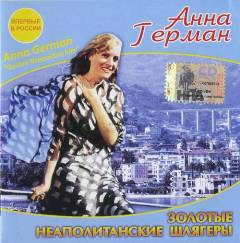Anna German – Golden Neapolitan Hits (2007)
Anna German – Golden Neapolitan Hits (2007)

01. Torna a surriento play 02. La piu bella del mondo 03. Santa lucia luntana 04. Funiculi funicula 05. Fenesta ca lucive 06. La nova gelosia 07. Gi (Giovane) 08. Non ho l'eta 09. Marechiaro 10. Te voglio bene assaje 11. Il cavallo bianco 12. Anema e core 13. La mamma play 14. Voce'e notte 15. Torne ru (Ogni volta) 16. Meglio dire di no 17. Dicitencello vuje 18. Prima...tu 19. Piscatore e pusilleco 20. Chi sei tu 21. 'O marenariello 22. Quatro Caritas
Canzone Napoletana, sometimes referred to as Neapolitan song, is a generic term for a traditional form of music sung in the Neapolitan language, ordinarily for the male voice singing solo, although well represented by female soloists as well, and expressed in familiar genres such as the lover's complaint or the serenade. It consists of a large body of composed popular music—such songs as O Sole Mio; Torna a Surriento; Funiculì, Funiculà; Santa Lucia and others.
The Neapolitan song became a formal institution in the 1830s due to an annual song-writing competition for the Festival of Piedigrotta, dedicated to the Madonna of Piedigrotta, a well-known church in the Mergellina area of Naples. The winner of the first festival was a song entitled Te voglio bene assaie; it is traditionally attributed to the prominent opera composer, Gaetano Donizetti, although an article published in 1984 by Marcello Sorce Keller shows there is no historical evidence in support of the attribution. The festival ran regularly until 1950, when it was abandoned. ---wikipedia
Początek pieśni neapolitańskiej w dzisiejszym znaczeniu tego terminu sięga roku 1835, kiedy to odbył się pierwszy festiwal w Piedigrotta w Neapolu. Był on organizowany mniej lub bardziej regularnie do pierwszych lat po drugiej wojnie światowej. Pierwszą triumfatorką festiwalu stała się pieśń Te voglio bene assaje, która zyskała dużą popularność. Autorstwo jej melodii przypisuje się Gaetano Donizettiemu. Złoty wiek pieśni neapolitańskiej to przełom XIX i XX wieku, kiedy stała się ona popularna poza granicami Włoch dzięki milionom emigrantów, którzy opuścili swój kraj (w tym Neapol). Pieśń neapolitańska szybko stała się synonimem Włoch na całym świecie. Znany włoski tenor, Enrico Caruso, wywodził się z Neapolu, a w Ameryce, poza normalnym repertuarem operowym, nagrał również wiele piosenek neapolitańskich (dla wytwórni RCA); śpiewał je też często jako bisy po występie w Metropolitan Opera w Nowym Jorku. Podobny zwyczaj miał również inny znany tenor Luciano Pavarotti. ---wikipedia
download: uploaded anonfiles yandex 4shared solidfiles mediafire mega filecloudio ziddu
Zmieniony (Niedziela, 10 Listopad 2013 17:47)








